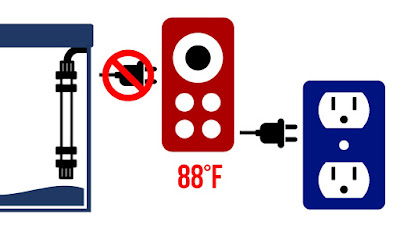Back when I was a beginner, I made the poor decision to buy a batch of used aquarium heaters. Gonna cut to the chase and recommend you never do that. Sure they’re only $5 a piece, but you don’t know how old they are, if the previous owner properly waited 30 minutes before turning it on, if they turned it off during water changes, etc. I had set up a quarantine tank with one of these used heaters and a few days later my husband Mr. Gamer noticed condensation and rust forming inside the glass heater tube. Oh no! Never again...
I currently use Aqueon Pro and Fluval LCD heaters, and they’ve been working well for me so far. However, I found out that many aquarium heaters, no matter how good, tend to eventually die. Now there’s several ways it can fail:
- It can just stop working and the water gets colder and colder, freezing your fish.
- It can stick on and get hotter and hotter until your fish cook to death.
- The heater itself can crack and leak toxic compounds into the tank, which is what happened to the King of DIY’s poor freshwater stingrays.
What is a Temperature Controller?
A temperature controller is an extra layer of protection to help maintain proper temperature in your aquarium. How it works is you plug your heater into the controller, plug the controller into the wall outlet, and set the temperature you want the controller to maintain. If your water ever gets too hot, the controller kills the power to the heater, thus preventing it from overheating. |
| A temperature controller kills the power to the aquarium heater if the water gets too hot. |
Yes, if you have an adjustable heater, it’ll have its own internal thermostat to maintain the temperature, but the controller’s thermostat and sensor are supposedly more accurate and having a second thermostat provides an extra safety net. When I looked on Amazon and fish forums, InkBird seemed to be the most popular brand. After reading some reviews, I got the basic ITC-308 model, which comes with one outlet for a heater and one outlet for cooling with a fan or chiller. InkBird also sent me a free ITC-306T (their new dual timer controller) to review, so I’m going to cover the features/differences between the two timers, how to set them up, and then give an honest assessment of what I really think of these InkBird controllers and whether or not they’re necessary.
Features of ITC-308 vs. ITC-306T
Okay, let’s start with the ITC-308 I bought for myself last year. It comes with this display unit, a temperature probe, the two outlets for heating and cooling, and a plug. My favorite feature is that it has alarms for when the temperature is too high or low.The new ITC-306T is different because it has two outlets for heating and you can set the heater to hit two different temperatures throughout the day – like a daytime and nighttime mode. Unfortunately, it doesn’t have a temperature alarm you can set, which I was surprised to find out.
If you'd like to see how to set them up, view the video above for step-by-step instructions.
Review of InkBird Temperature Controllers
Well, I just got the ITC-306T for review, but I personally wouldn’t get it because I have no need for temperature changes throughout the day. I’m guessing certain reptiles or other pets like distinct daytime and nighttime temperatures. Or maybe if you wanted to make the fish or shrimp you breed hardier and more adaptable to a wide range of temperatures, you could use this. However, the lack of adjustable temperature alarms was a no-go for me.As for the original ITC-308 I bought, I’m going to be honest and let you know that about 6 months after I set it up, the temperature reading started climbing and climbing to over 100°F, even though my digital thermometer said the water was still at 78°F. I went to InkBird’s website, found out they have a 1-year warranty, and emailed them. The customer rep immediately responded and helped me troubleshoot the issue, told me I had a faulty temperature probe, and sent me a brand-new unit via Amazon.com that arrived two days later. Didn’t have to return the old controller or wait two months for the new one to ship from China or anything.
Final Thoughts: Should You Get a Heater Controller?
I still think it’s worth it to get a temperature controller for any display aquariums or special fish you really care about, just as extra protection against overheating. But for all my other tanks, I’ve started using an industrial digital thermometer by General Tools because it’s very reliable compared to the cheap Zoo Med ones and it has high and low alarm settings that you can program. It won't save your tank from overheating if you're not home, but it’s definitely saved my fish a few times when I forgot to turn on the heater after a water change.If you like the idea of a heater controller and aren’t afraid of DIY projects, the King of DIY has a popular tutorial on how to make your own. Also, huge thanks to Hannah Horinek for being the latest supporter on my Patreon! Take time to enjoy your aquariums and I’ll see you in the next video.
Subscribe to my YouTube Channel for practical fish care tips for busy aquarists and follow me on Instagram for more updates! 🎮❤️🐟



No comments:
Post a Comment